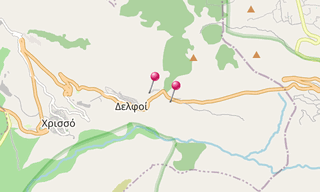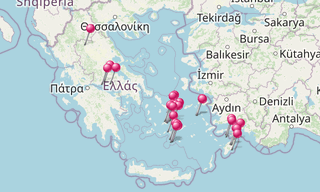Delphi (Δελφοί) is an archaeological site on the south-western spur of Mount Parnassus in the valley of Phocis. In myths dating to the classical period of Ancient Greece (510 - 323 BC), the site of Delphi was believed to be determined by Zeus when he sought to find the centre of his “Grandmother Earth” (Ge, Gaea, or Gaia). Delphi is perhaps best known for the oracle at the sanctuary that was dedicated to Apollo during the classical period.
Apollo’s sacred precinct in Delphi was a panhellenic sanctuary, where every four years, starting in 586 BC athletes from all over the Greek world competed in the Pythian Games, one of the four panhellenic (or stephanitic) games, precursors of the Modern Olympics. The victors at Delphi were presented with a laurel crown (Stephanos).
These Pythian Games rank second among the four stephanitic games chronologically and based on importance. These games, though, were different from the games at Olympia in that they were not of such vast importance to the city of Delphi as the games at Olympia were to the area surrounding Olympia. Delphi would have been a renowned city whether or not it hosted these games; it had other attractions that led to it being labeled the “omphalos” (navel) of the earth, in other words, the center of the world.
Main Buildings and Structures
- The ruins of the Temple of Apollo of Delphi visible today date from the 4th century BC, and are of a peripteral Doric building. It was erected on the remains of an earlier temple, dated to the 6th century BC which itself was erected on the site of a 7th century BC construction attributed to the architects Trophonios and Agamedes.
- The Athenian Treasury built to commemorate the Athenians’ victory at the Battle of Marathon in 490 BC.
- The Ancient Theatre at Delphi was built further up the hill from the Temple of Apollo giving spectators a view of the entire sanctuary and the valley below. It was originally built in the 4th century BC but was remodeled on several occasions since. Its 35 rows can seat 5,000 spectators.
- The Tholos at the sanctuary of Athena Pronoia“Athena of forethought” is a circular building that was constructed between 380 and 360 BC. It consisted of 20 Doric columns arranged with an exterior diameter of 14.76 m, with 10 Corinthian columns in the interior.
- The Stadium is located further up the hill, beyond the Via Sacra and the theatre. It was originally built in the 5th century BC but was altered in later centuries. The last major remodeling took place in the 2nd century AD under the patronage of Herodes Atticus when the stone seating was built and (arched) entrance. It could seat 6,500 spectators and the track was 177 m long and 25.5 m wide.

-Tholos-at-Sanctuary-of-Athena-Pronaia.hero.landscape.jpg?w=1600)

-Tholos-at-Sanctuary-of-Athena-Pronaia.jpg?w=256)
-Temple-of-Apollo.jpg?w=256)
-Tholos-at-Sanctuary-of-Athena-Pronaia.jpg?w=256)
-Theater.jpg?w=256)
-Treasure-of-the-Athenians.jpg?w=256)
-Theater.jpg?w=256)
.jpg?w=256)
-Theater.jpg?w=256)
-Theater.jpg?w=256)
-Tholos-at-Sanctuary-of-Athena-Pronaia.jpg?w=256)
-Temple-of-Apollo.jpg?w=256)
-Tholos-at-Sanctuary-of-Athena-Pronaia.jpg?w=256)
-Treasure-of-the-Athenians.jpg?w=256)
-Theater.jpg?w=256)
-Tholos-at-Sanctuary-of-Athena-Pronaia.jpg?w=256)
-Treasure-of-the-Athenians.jpg?w=256)
-Treasure-of-the-Athenians.jpg?w=256)
-Tholos-at-Sanctuary-of-Athena-Pronaia.jpg?w=256)
.jpg?w=256)
.jpg?w=256)
-Tholos-at-Sanctuary-of-Athena-Pronaia.jpg?w=256)
-Theater.jpg?w=256)
-Theater.jpg?w=256)
-Theater.jpg?w=256)
-Theater.jpg?w=256)
-Theater.jpg?w=256)
-Temple-of-Apollo.jpg?w=256)
.jpg?w=256)
-Tholos-at-Sanctuary-of-Athena-Pronaia.jpg?w=256)
-Tholos-at-Sanctuary-of-Athena-Pronaia.jpg?w=256)
-Treasure-of-the-Athenians.jpg?w=256)
-Treasure-of-the-Athenians.jpg?w=256)
-Tholos-at-Sanctuary-of-Athena-Pronaia.jpg?w=256)
-Tholos-at-Sanctuary-of-Athena-Pronaia.jpg?w=256)
-Temple-of-Apollo.jpg?w=256)
-Stadium.jpg?w=256)
-Stadium.jpg?w=256)
-Tholos-at-Sanctuary-of-Athena-Pronaia.jpg?w=256)
.jpg?w=256)
-Temple-of-Apollo.jpg?w=256)
-Theater.jpg?w=256)
-Theater.jpg?w=256)
-Temple-of-Apollo.jpg?w=256)
-Theater.jpg?w=256)
-Tholos-at-Sanctuary-of-Athena-Pronaia.jpg?w=256)
-Theater.jpg?w=256)
-Tholos-at-Sanctuary-of-Athena-Pronaia.jpg?w=256)
-Temple-of-Apollo.jpg?w=256)
-Fira.hero.jpg?w=320)

.hero.jpg?w=320)
.map.png)